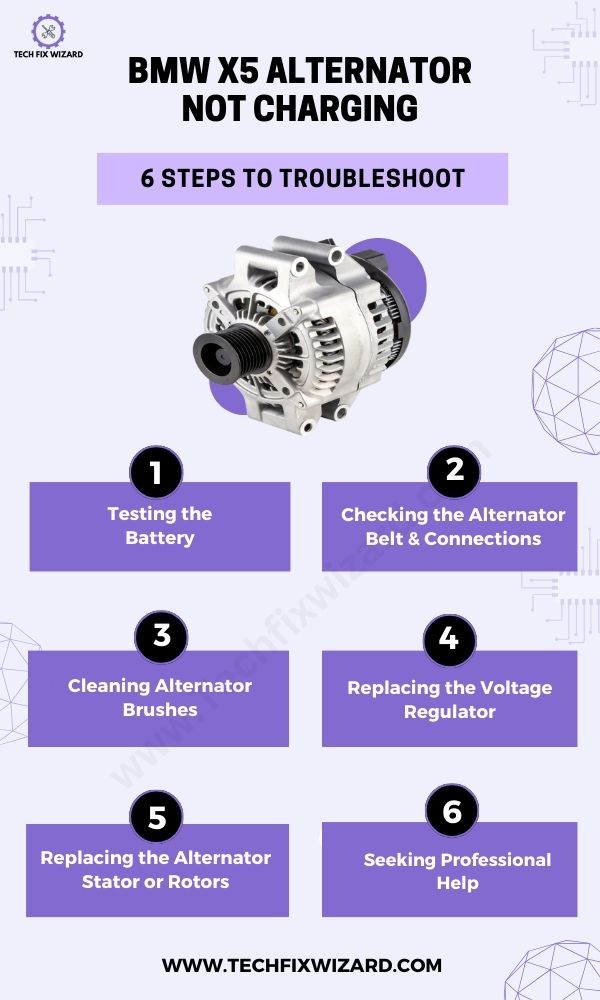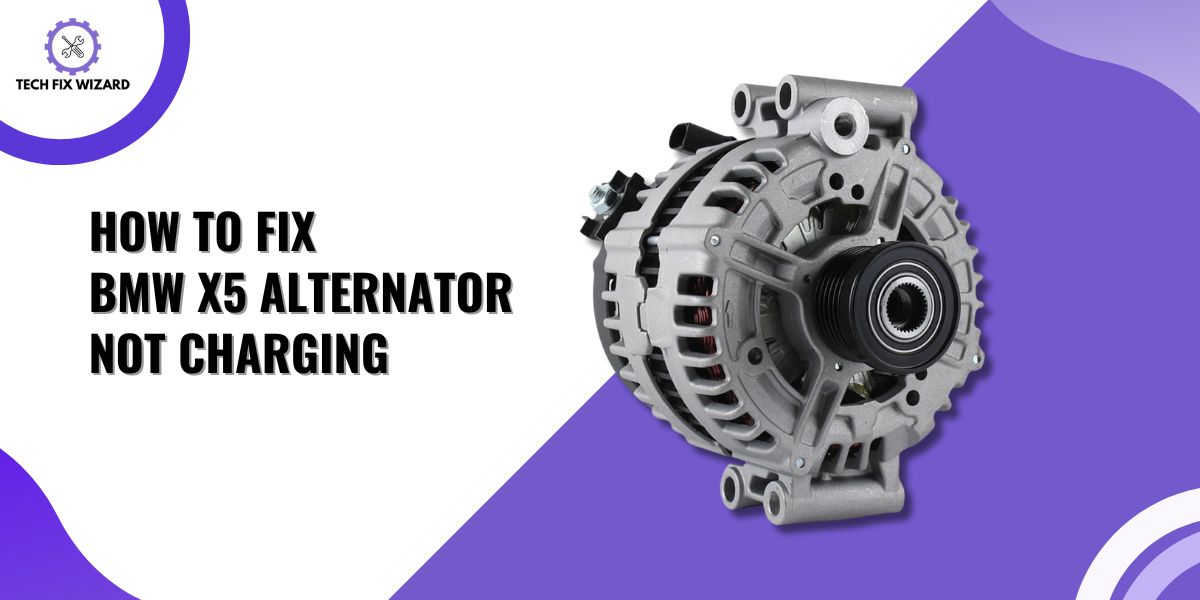The alternator plays a crucial role in the electrical system of a vehicle, including the BMW X5. It is responsible for generating electrical power and charging the battery while the engine is running.
However, encountering an issue where the alternator is not charging can be a frustrating experience for any vehicle owner.
In this article, we will explore some possible reasons behind the BMW X5 alternator not charging issue and discuss potential solutions to rectify it.
Contents
- 1 BMW X5 Alternator Not Charging –
- 2 5 Possible Causes
- 3 6 Signs of BMW X5 Alternator Not Charging
- 4 Troubleshooting BMW X5 Alternator Not Charging
- 5 1. Testing the Battery
- 6 2. Checking the Alternator Belt and Connections
- 7 3. Cleaning and Replacing the Alternator Brushes
- 8 4. Replacing the Voltage Regulator
- 9 5. Repairing or Replacing the Alternator Stator or Rotor
- 10 6. Seeking Professional Help
- 11 Preventative Maintenance for Your BMW X5 Alternator
- 12 FAQs
- 13 1. What are the signs of a BMW X5 alternator not charging?
- 14 2. How can I determine if my BMW X5’s alternator is not charging?
- 15 3. What could be the possible reasons for the alternator in my BMW X5 not charging?
- 16 4. Is it safe to drive my BMW X5 if the alternator is not charging?
- 17 5. Can a dead battery cause the alternator in a BMW X5 not to charge?
- 18 6. How much does it typically cost to repair or replace a BMW X5 alternator that is not charging?
- 19 7. Are there any DIY methods to troubleshoot or fix an alternator not charging issue in a BMW X5?
- 20 8. Are there any common issues specific to BMW X5 alternators not charging?
- 21 9. Can a faulty voltage regulator cause the alternator in a BMW X5 not to charge?
- 22 Official References & Resources
BMW X5 Alternator Not Charging –
5 Possible Causes
When faced with the BMW X5 alternator not charging issue, it’s important to consider the various possible causes outlined in the table.
| Possible Causes | Description |
|---|---|
| 1. Faulty alternator | Internal components of the alternator are worn out or damaged, resulting in insufficient power generation. |
| 2. Defective voltage regulator | A malfunctioning voltage regulator disrupts the charging process, leading to inconsistent or inadequate charging. |
| 3. Loose or damaged wiring | Poor connections or damaged wiring between the alternator, battery, and other electrical components hinder the flow of electricity, impacting charging. |
| 4. Malfunctioning drive belt | A worn or damaged drive belt can slip or break, preventing the alternator from rotating properly and generating power for charging. |
| 5. Battery issues | Weak or defective batteries, as well as faulty battery cables or terminals, can hinder the charging process and falsely indicate a non-charging alternator. |
6 Signs of BMW X5 Alternator Not Charging
Signs of the BMW X5 alternator not charging issue can manifest in various ways. Here are some common signs to look out for:
| No. | Signs |
|---|---|
| 1. | Dim or flickering lights |
| 2. | Battery or charging system warning lights |
| 3. | Weak or dead battery |
| 4. | Electrical issues (malfunctioning power windows, erratic power seat operation, radio or audio system issues, intermittent or non-functional accessories) |
| 5. | Strange noises (grinding, whining, or squealing sounds) |
| 6. | Battery warning on iDrive screen (applicable to certain BMW X5 models) |
Troubleshooting BMW X5 Alternator Not Charging
When faced with an alternator not charging issue in your BMW X5, taking a systematic approach to troubleshooting is essential.
Following are the 6 troubleshooting steps to resolve the BMW X5 alternator not charging issue:

Read More: BMW X5 Hybrid Not Charging – 5 Steps To Resolve It
1. Testing the Battery
When troubleshooting an alternator not charging issue in a BMW X5, testing the battery is an important first step.
A weak or defective battery can affect the charging system’s performance and falsely indicate an alternator problem.
Here are the steps to test the battery:
– Safety precautions:
Before starting, ensure the engine is turned off, and all electrical accessories are switched off. Wear appropriate safety gear, such as rubber or insulated gloves to protect yourself.
– Visual Inspection:
Inspect the battery for any signs of physical damage, leakage, or corrosion on the terminals. Clean any corrosion using a battery terminal cleaner or a mixture of baking soda and water.
– Open Circuit Voltage (OCV) Test:
Use a digital multimeter set to DC voltage and place the positive (red) probe on the positive terminal of the battery and the negative (black) probe on the negative terminal.
Measure the voltage reading without the engine running. A fully charged battery typically reads around 12.6 to 12.8 volts. Anything significantly lower may indicate a weak battery.
– Load Testing:
If the OCV test shows a lower voltage or if you suspect the battery is weak, perform a load test. You can use a battery load tester for this.
Follow the instructions provided by the load tester and apply a load to the battery while monitoring the voltage. A healthy battery should maintain a voltage above 9.6 volts during the load test.
– Charging & Retesting:
If the battery voltage is low or fails the load test, charge the battery using an appropriate battery charger. Once fully charged, retest the battery using the OCV test to ensure it reaches the recommended voltage range.
– Inspect Battery Cables:
While testing the battery, inspect the battery cables for any signs of damage, looseness, or corrosion. Clean and tighten the connections if necessary.
2. Checking the Alternator Belt and Connections
When it comes to troubleshooting an alternator not charging issue in your BMW X5, checking the alternator belt and connections is the second crucial step in the process.
– Inspect the Alternator Belt
- Visually inspect the alternator belt for signs of wear, such as cracks, fraying, or glazing.
- Use a tension gauge to measure the tightness of the alternator belt against the pulleys.
- Listen for any squealing noises when starting the engine or activating electrical accessories, as it may indicate a loose or slipping alternator belt.
- Address any issues with the alternator belt promptly, either by adjusting its tension or replacing it if necessary.

– Examine the Alternator Connections
- Examine the alternator connections, ensuring that all wires and terminals are securely attached and free from corrosion or damage.
- Use a voltmeter to test the continuity between each connection point to identify any resistance or faulty connections.
- Repair or replace any damaged or corroded alternator connections to ensure optimal electrical transfer.
Also Read: BMW X5 E53 Battery Not Charging – 9 Solutions To Try
3. Cleaning and Replacing the Alternator Brushes
Cleaning and replacing the alternator brushes is an important maintenance task that can help restore the charging efficiency of your BMW X5’s alternator.
Over time, the brushes can wear down or become dirty, leading to poor electrical contact and reduced charging performance.
Here are the steps to cleaning and replacing the alternator brushes:
- Remove the alternator from the vehicle.
- Carefully disassemble the alternator to access the brushes.
- Take note of the position of the old brushes before removing them.
- Clean the inside of the alternator casing using a soft-bristled brush or compressed air.
- Use a high-quality replacement brush specifically designed for your BMW X5.
- Handle the brushes with care as they are fragile and can easily break.
- Install the new brushes in the correct position, aligning them properly.
- Reassemble the alternator, following the reverse steps of disassembly.
- While the alternator is out, inspect other components for signs of wear or damage.
- Refer to the vehicle’s manual for any specific guidelines during reinstallation.
- Once the alternator is back in place, test the charging system to ensure proper functionality.

4. Replacing the Voltage Regulator
Replacing the voltage regulator is a crucial step in resolving charging issues in your BMW X5’s electrical system.
Signs indicating the need for voltage regulator replacement include inconsistent or weak charging.
Here are the steps to replace the voltage regulator in your BMW X5:
- Disconnect the battery and remove the necessary components to access the alternator.
- Locate the screws or bolts holding the voltage regulator in place.
- Carefully disconnect wires and connectors, noting their original positions.
- Remove the old voltage regulator.
- Install the new voltage regulator in its place.
- Reconnect wires and connectors, ensuring proper connections.
- Reinstall any components that were previously removed.
- Reconnect the battery.
- Start the BMW X5 and verify if the charging system is working properly.
Read More: BMW X5 Battery Not Charging – 6 Troubleshooting Steps
5. Repairing or Replacing the Alternator Stator or Rotor
Repairing or replacing the alternator stator or rotor is another possible solution when troubleshooting a BMW X5 alternator not charging. As these components play a crucial role in generating electrical power.
Here are the steps involved:
| Step | Description |
|---|---|
| 1. | Disconnect the battery for safety. |
| 2. | Remove the alternator from the vehicle by loosening the mounting bolts and disconnecting electrical connections. |
| 3. | Identify whether the issue is with the stator or rotor. |
| 4. | If the stator is damaged or faulty, carefully remove it from the alternator assembly. |
| 5. | Replace the faulty stator with a new one, ensuring compatibility with your specific BMW X5 model. |
| 6. | If the rotor is the cause of the issue, remove it from the alternator assembly. |
| 7. | Replace the damaged or faulty rotor with a new one matching your BMW X5’s specifications. |
| 8. | Reassemble the alternator, ensuring all connections and mounting bolts are properly tightened. |
| 9. | Reinstall the alternator back into the vehicle and reconnect all electrical connections. |
| 10. | Finally, reconnect the battery and test the charging system to ensure it is functioning correctly. |
6. Seeking Professional Help
If you have tried all the above steps and the issue with your BMW X5 alternator still isn’t resolved, it is recommended to seek professional help.
Find a qualified mechanic specializing in BMWs, with good reviews and fair pricing. Fixing an alternator requires expertise beyond simple replacements, such as diagnosing related components and underlying causes.
Trusting professionals saves time, and money, and ensures accurate repairs.
Preventative Maintenance for Your BMW X5 Alternator
Preventative maintenance for your BMW X5 alternator is essential to ensure its optimal performance and longevity.
Here are some key points to consider:
- Schedule regular inspections with a qualified mechanic to check belts, wiring, and overall condition.
- Test the battery and alternator during inspections to ensure proper functioning.
- Keep the alternator clean to prevent debris buildup.
- Check and maintain belt condition and tension.
- Periodically inspect the entire electrical system, including connections and fuses.
Remember, preventative maintenance can save you from unexpected breakdowns, costly repairs, and inconvenience.
People Also Liked:
FAQs
1. What are the signs of a BMW X5 alternator not charging?
Some common signs of a BMW X5 alternator not charging include dimming or flickering headlights, a warning light on the dashboard indicating low battery or charging system issues, difficulty starting the vehicle, frequent battery replacements, and electrical components not functioning properly.
2. How can I determine if my BMW X5’s alternator is not charging?
To determine if your BMW X5’s alternator is not charging, you can use a multimeter to measure the voltage across the battery terminals. With the engine running, a healthy alternator should produce a voltage reading between 13.5 and 14.5 volts.
If the reading is significantly lower or fluctuates, it indicates a charging problem.
3. What could be the possible reasons for the alternator in my BMW X5 not charging?
There are several potential reasons for an alternator in a BMW X5 not charging.
Common causes include a faulty alternator, a damaged or worn-out serpentine belt, a defective voltage regulator, a blown fuse, a broken or loose connection, or a problem with the battery itself.
4. Is it safe to drive my BMW X5 if the alternator is not charging?
It is not safe to drive a BMW X5 if the alternator is not charging. The battery will eventually lose power, leading to a complete breakdown of the vehicle.
Additionally, the electrical components may stop functioning properly, posing a risk to your safety and potentially leaving you stranded.
5. Can a dead battery cause the alternator in a BMW X5 not to charge?
Yes, a dead or severely discharged battery can cause the alternator in a BMW X5 not to charge properly. The alternator relies on the battery to establish a circuit and initial power supply.
If the battery is dead, it cannot provide the necessary initial charge to activate the alternator.
6. How much does it typically cost to repair or replace a BMW X5 alternator that is not charging?
The cost to repair or replace a BMW X5 alternator that is not charging can vary depending on factors such as the model year, location, and whether you choose an OEM (Original Equipment Manufacturer) or aftermarket part.
On average, the cost can range from $400 to $800, including labor charges.
7. Are there any DIY methods to troubleshoot or fix an alternator not charging issue in a BMW X5?
While diagnosing and fixing alternator issues can be complex, there are a few DIY methods you can try. These include checking the serpentine belt for damage or wear, inspecting and tightening electrical connections, and testing the battery voltage.
However, it is recommended to consult a professional technician for a thorough diagnosis and repair.
8. Are there any common issues specific to BMW X5 alternators not charging?
Some common issues specific to BMW X5 alternators not charging include voltage regulator failure, worn-out brushes, faulty diodes, and worn or damaged wiring harnesses.
These issues can impact the charging capability of the alternator and require attention from a qualified mechanic.
9. Can a faulty voltage regulator cause the alternator in a BMW X5 not to charge?
Yes, a faulty voltage regulator can cause the alternator in a BMW X5 not to charge.
Other Relevant Picks By Us:
- BMW Wallbox Not Charging – 6 Effective Solutions To Try
- BMW Battery Not Charging While Stopped – [SOLVED]
Official References & Resources
Our research for providing accurate information about BMW involved a thorough analysis of official resources, including the official BMW website owner’s manuals, technical specifications, and relevant support forums.
Our research and data gathering involved thorough analysis of the official websites, including:

John Paul is a tech enthusiast dedicated to troubleshooting. He is passionate about fixing glitches, simplifying complexities, and empowering others in the digital realm.

